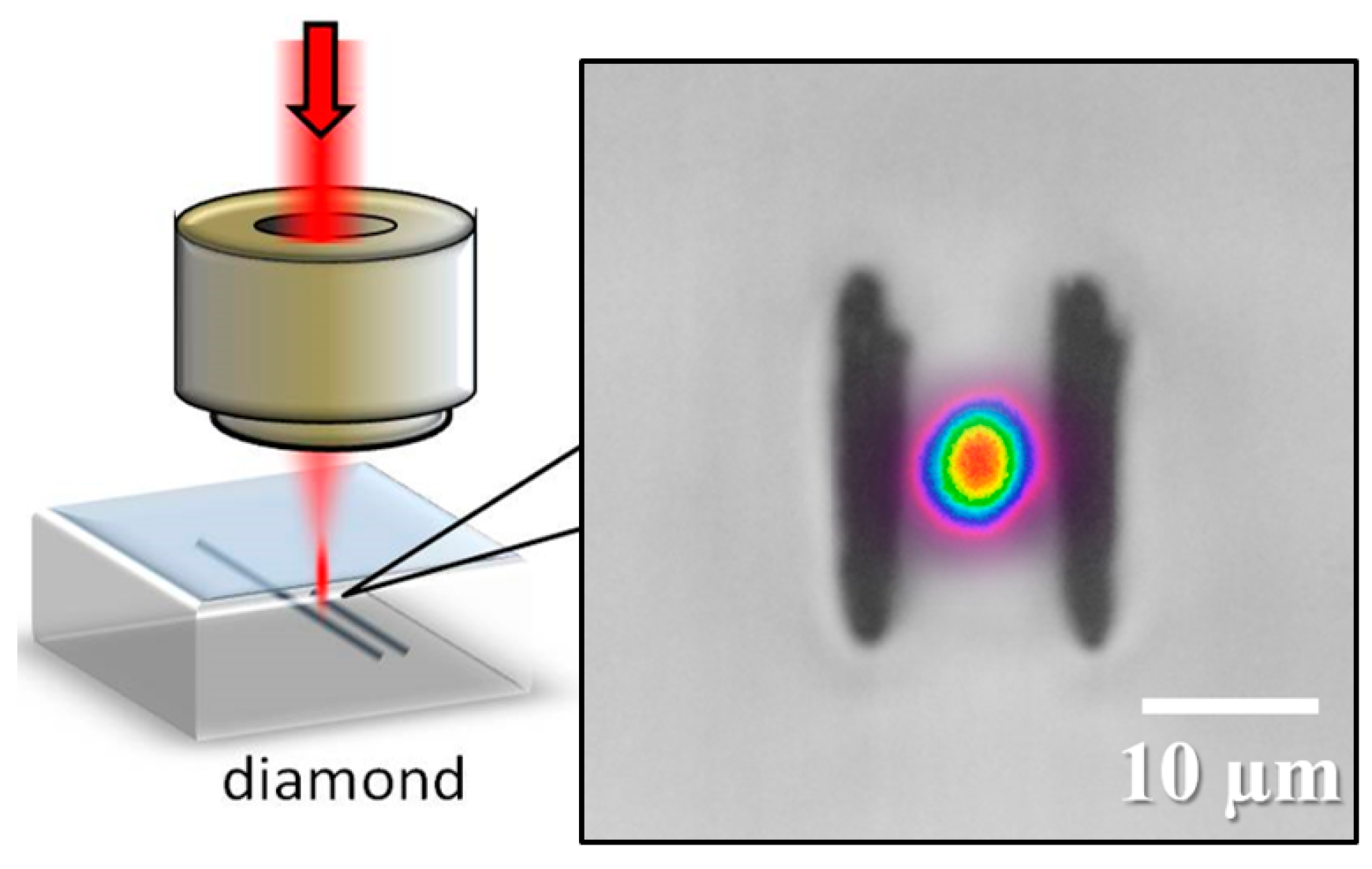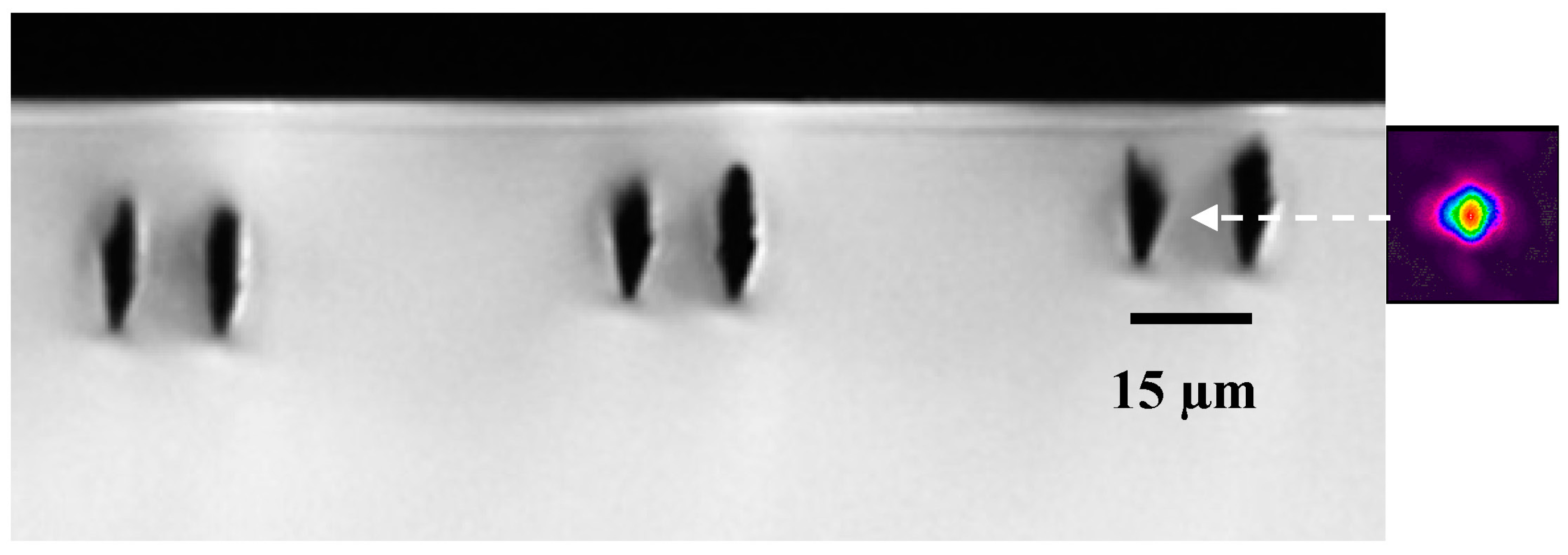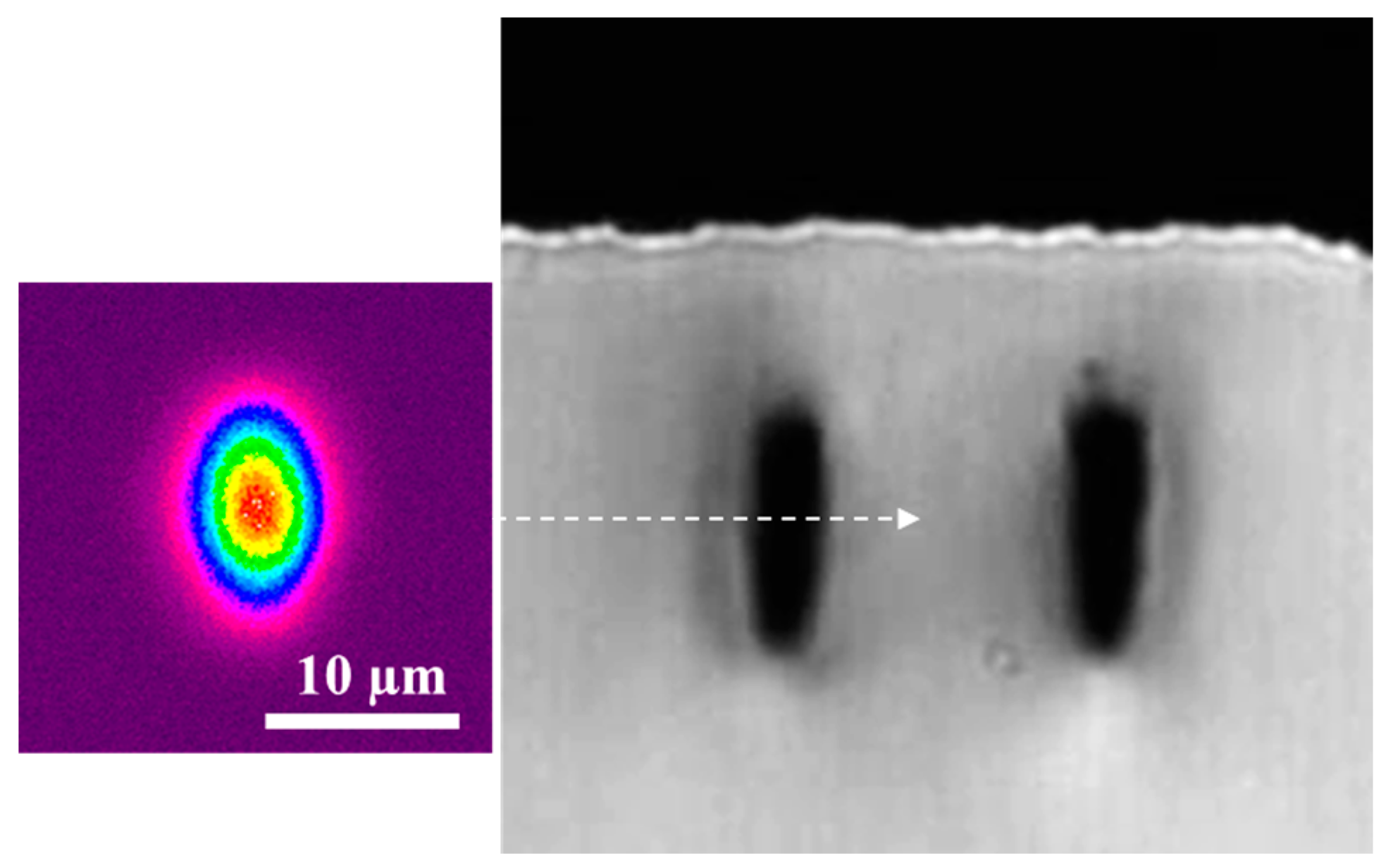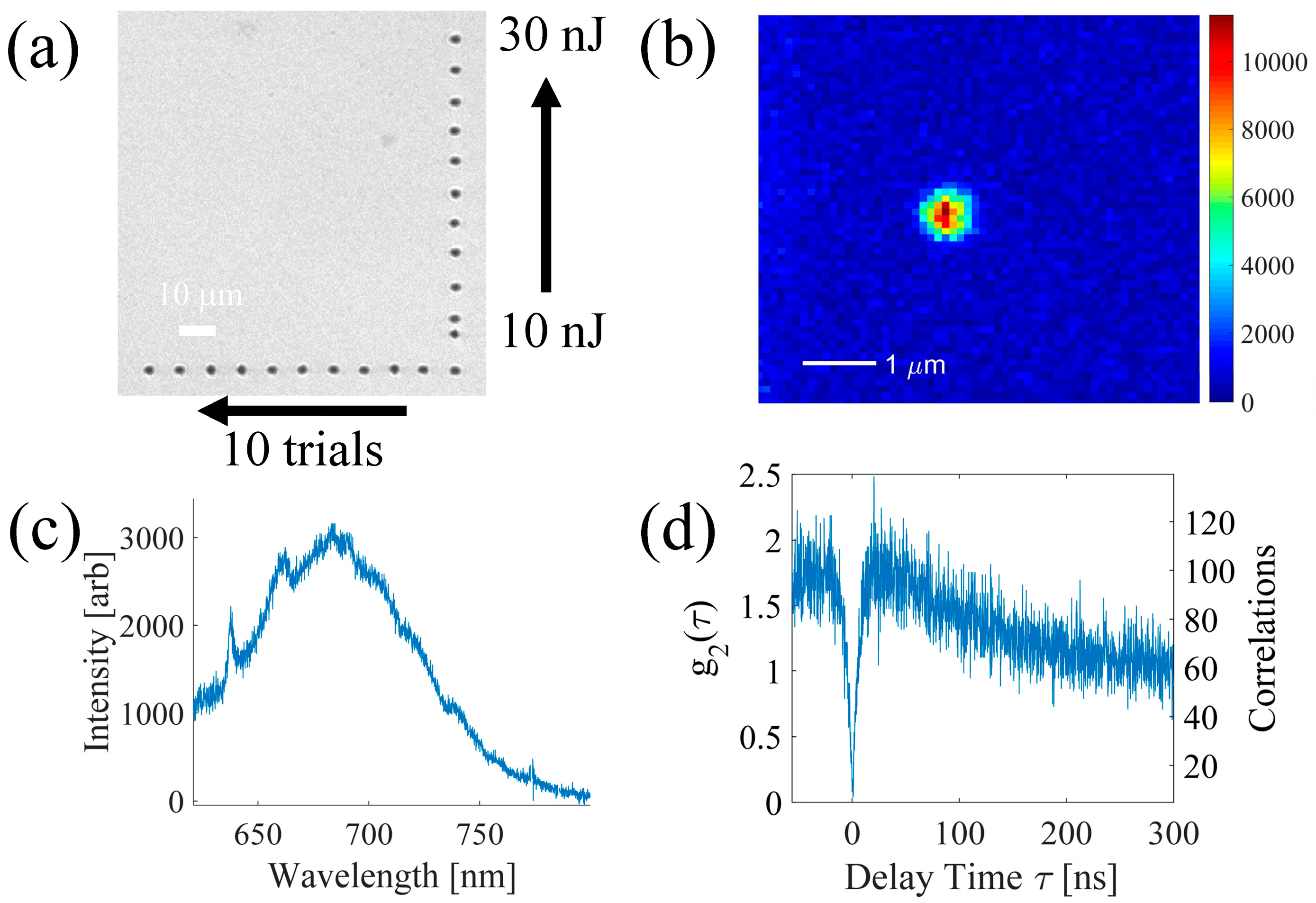Visible to Infrared Diamond Photonics Enabled by Focused Femtosecond Laser Pulses
Abstract
:1. Introduction
2. Materials and Methods
3. Results and Discussion
3.1 Optical Waveguides
3.1.1 µ-Raman Spectroscopy and Photoluminescence in the Waveguiding Region
3.1.2 Shallow Waveguides for Sensing and Magnetometry
3.2. NV Centers in Quantum Grade Diamond
4. Conclusions
Acknowledgments
Author Contributions
Conflicts of Interest
References
- Balasubramanian, G.; Neumann, P.; Twitchen, D.; Markham, M.; Kolesov, R.; Mizuochi, N.; Isoya, J.; Achard, J.; Beck, J.; Tissler, J.; et al. Ultralong spin coherence time in isotopically engineered diamond. Nat. Mater. 2009, 8, 383–387. [Google Scholar] [CrossRef] [PubMed]
- Hiscocks, M.P.; Ganesan, K.; Gibson, B.C.; Huntington, S.T.; Ladouceur, F.; Prawer, S. Diamond waveguides fabricated by reactive ion etching. Opt. Express 2008, 16, 19512–19519. [Google Scholar] [CrossRef] [PubMed]
- Lagomarsino, S.; Olivero, P.; Bosia, F.; Vannoni, M.; Calusi, S.; Giuntini, L.; Massi, M. Evidence of light guiding in ion-implanted diamond. Phys. Rev. Lett. 2010, 105, 233903. [Google Scholar] [CrossRef] [PubMed]
- Sotillo, B.; Bharadwaj, V.; Hadden, J.P.; Sakakura, M.; Chiappini, A.; Fernandez, T.T.; Longhi, S.; Jedrkiewicz, O.; Shimotsuma, Y.; Criante, L.; et al. Diamond photonics platform enabled by femtosecond laser writing. Sci. Rep. 2016, 6, 35566. [Google Scholar] [CrossRef] [PubMed]
- Courvoisier, A.; Booth, M.J.; Salter, P.S. Inscription of 3D waveguides in diamond using an ultrafast laser. Appl. Phys. Lett. 2016, 109, 031109. [Google Scholar] [CrossRef]
- Burghoff, J.; Grebing, C.; Nolte, S.; Tünnermann, A. Efficient frequency doubling in femtosecond laser-written waveguides in lithium niobate. Appl. Phys. Lett. 2006, 89, 081108. [Google Scholar] [CrossRef]
- Orwa, J.O.; Santori, C.; Fu, K.M.C.; Gibson, B.; Simpson, D.; Aharonovich, I.; Stacey, A.; Cimmino, A.; Balog, P.; Markham, M.; et al. Engineering of nitrogen-vacancy color centers in high purity diamond by ion implantation and annealing. J. Appl. Phys. 2011, 109, 083530. [Google Scholar] [CrossRef]
- Chen, Y.C.; Salter, P.S.; Knauer, S.; Weng, L.; Frangeskou, A.C.; Stephen, C.J.; Ishmael, S.N.; Dolan, P.R.; Johnson, S.; Green, B.L.; et al. Laser writing of coherent colour centres in diamond. Nat. Photonics 2017, 11, 77–80. [Google Scholar] [CrossRef]
- Fontanella, J.; Johnston, R.L.; Colwell, J.H.; Andeen, C. Temperature and pressure variation of the refractive index of diamond. Appl. Opt. 1977, 16, 2949–2951. [Google Scholar] [CrossRef] [PubMed]
- Olivero, P.; Calusi, S.; Giuntini, L.; Lagomarsino, S.; Giudice, A.L.; Massi, M.; Sciortino, S.; Vannoni, M.; Vittone, E. Controlled variation of the refractive index in ion-damaged diamond. Diam. Relat. Mater. 2010, 19, 428–431. [Google Scholar] [CrossRef]
- Guo, A.; Salamo, G.J.; Duchesne, D.; Morandotti, R.; Volatier-Ravat, M.; Aimez, V.; Siviloglou, G.A.; Christodoulides, D.N. Observation of P T-symmetry breaking in complex optical potentials. Phys. Rev. Lett. 2009, 103, 093902. [Google Scholar] [CrossRef] [PubMed]
- Von Kaenel, Y.; Stiegler, J.; Michler, J.; Blank, E. Stress distribution in heteroepitaxial chemical vapor deposited diamond films. J. Appl. Phys. 1997, 81, 1726–1736. [Google Scholar] [CrossRef]
- Benayas, A.; Silva, W.F.; Ródenas, A.; Jacinto, C.; de Aldana, J.V.; Chen, F.; Tan, Y.; Thomsom, R.R.; Psaila, N.D.; Reid, D.T.; et al. Ultrafast laser writing of optical waveguides in ceramic Yb:YAG: A study of thermal and non-thermal regimes. Appl. Phys. A 2011, 104, 301–309. [Google Scholar] [CrossRef]
- Olivero, P.; Bosia, F.; Fairchild, B.A.; Gibson, B.C.; Greentree, A.D.; Spizzirri, P.; Prawer, S. Splitting of photoluminescent emission from nitrogen–vacancy centers in diamond induced by ion-damage-induced stress. New J. Phys. 2013, 15, 043027. [Google Scholar] [CrossRef]
- Gökay, U.S.; Zakwan, M.; Serpengüzel, A. Spherical silicon optical resonators: Possible applications to biosensing. Eur. Phys. J. Spec. Top. 2014, 223, 2003–2008. [Google Scholar] [CrossRef]
- Çirkinoğlu, H.O.; Gökay, U.S.; Sotillo, B.; Bharadwaj, V.; Ramponi, R.; Eaton, S.M.; Serpengüzel, A. Resonant directional coupling to silicon microspheres by glass optical waveguides fabricated by femtosecond laser. Opt. Express 2016, submitted. [Google Scholar]
- Streltsov, A.M.; Borrelli, N.F. Study of femtosecond-laser-written waveguides in glasses. J. Opt. Soc. Am. B 2002, 19, 2496–2504. [Google Scholar] [CrossRef]
- Chan, J.W.; Huser, T.R.; Risbud, S.H.; Krol, D.M. Modification of the fused silica glass network associated with waveguide fabrication using femtosecond laser pulses. Appl. Phys. A 2003, 76, 367–372. [Google Scholar] [CrossRef]
- Courrol, L.C.; Samad, R.E.; Gomes, L.; Ranieri, I.M.; Baldochi, S.L.; de Freitas, A.Z.; Junior, N.D.V. Color center production by femtosecond pulse laser irradiation in LiF crystals. Opt. Express 2004, 12, 288–293. [Google Scholar] [CrossRef] [PubMed]
- Rabeau, J.R.; Reichart, P.; Tamanyan, G.; Jamieson, D.N.; Prawer, S.; Jelezko, F.; Gaebel, T.; Popa, I.; Domhan, M.; Wrachtrup, J. Implantation of labelled single nitrogen vacancy centers in diamond using N15. Appl. Phys. Lett. 2006, 88, 023113. [Google Scholar] [CrossRef]
- Naydenov, B.; Reinhard, F.; Lämmle, A.; Richter, V.; Kalish, R.; D’Haenens-Johansson, U.F.; Newton, M.; Jelezko, F.; Wrachtrup, J. Increasing the coherence time of single electron spins in diamond by high temperature annealing. Appl. Phys. Lett. 2010, 97, 242511. [Google Scholar] [CrossRef]
- Yamamoto, T.; Umeda, T.; Watanabe, K.; Onoda, S.; Markham, M.L.; Twitchen, D.J.; Naydenov, B.; McGuinness, L.P.; Teraji, T.; Koizumi, S.; et al. Extending spin coherence times of diamond qubits by high-temperature annealing. Phys. Rev. B 2013, 88, 075206. [Google Scholar] [CrossRef]
- Brouri, R.; Beveratos, A.; Poizat, J.P.; Grangier, P. Photon antibunching in the fluorescence of individual color centers in diamond. Opt. Lett. 2000, 25, 1294–1296. [Google Scholar] [CrossRef] [PubMed]





© 2017 by the authors. Licensee MDPI, Basel, Switzerland. This article is an open access article distributed under the terms and conditions of the Creative Commons Attribution (CC BY) license ( http://creativecommons.org/licenses/by/4.0/).
Share and Cite
Sotillo, B.; Bharadwaj, V.; Hadden, J.P.; Rampini, S.; Chiappini, A.; Fernandez, T.T.; Armellini, C.; Serpengüzel, A.; Ferrari, M.; Barclay, P.E.; et al. Visible to Infrared Diamond Photonics Enabled by Focused Femtosecond Laser Pulses. Micromachines 2017, 8, 60. https://doi.org/10.3390/mi8020060
Sotillo B, Bharadwaj V, Hadden JP, Rampini S, Chiappini A, Fernandez TT, Armellini C, Serpengüzel A, Ferrari M, Barclay PE, et al. Visible to Infrared Diamond Photonics Enabled by Focused Femtosecond Laser Pulses. Micromachines. 2017; 8(2):60. https://doi.org/10.3390/mi8020060
Chicago/Turabian StyleSotillo, Belén, Vibhav Bharadwaj, John Patrick Hadden, Stefano Rampini, Andrea Chiappini, Toney T. Fernandez, Cristina Armellini, Ali Serpengüzel, Maurizio Ferrari, Paul E. Barclay, and et al. 2017. "Visible to Infrared Diamond Photonics Enabled by Focused Femtosecond Laser Pulses" Micromachines 8, no. 2: 60. https://doi.org/10.3390/mi8020060





